- Home
- Jared Diamond
Upheaval: Turning Points for Nations in Crisis Page 16
Upheaval: Turning Points for Nations in Crisis Read online
Page 16
South American military governments usually prefer an economy that they control themselves for their own benefit, rather than a free-market economy that they don’t control. Hence the junta’s adoption of the Chicago Boys’ policies was unexpected, and it remains uncertain why it happened. It might not have happened at all without Pinochet, because the policies were opposed by some senior Chilean military officers, including one junta member (Air Force General Gustavo Leigh) whom Pinochet finally forced to resign in 1978. The adoption is sometimes attributed to the 1975 Chilean visit of Milton Friedman himself, who met with Pinochet for 45 minutes and followed up the meeting by sending Pinochet a long letter full of recommendations. But Friedman came away from the meeting with a low opinion of Pinochet, who asked Friedman only one question during their conversation. In fact, the Chicago Boys’ program differed significantly from Friedman’s recommendations and drew on detailed plans that Chilean economists had already laid out in a document nicknamed “the brick” (because it was so lengthy and heavy).
A possible explanation is that Pinochet recognized that he knew nothing about economics, portrayed himself as (or was) a simple man, and found appealing the Chicago Boys simple, consistent, persuasive proposals. Another factor may be that Pinochet identified the Chicago Boys and their policies with the U.S., which strongly supported Pinochet, shared his hatred of communists, and resumed its loans to Chile immediately after Pinochet’s coup. As true of some other actions of Pinochet (and of Allende), the motives in this case as well are not clear.
Whatever the motives, the resulting free-market policies included the re-privatization of hundreds of state-owned businesses nationalized under Allende (but not of the copper companies); the slashing of the government deficit by across-the-board cuts of every government department’s budget by 15% to 25%; the slashing of average import duties from 120% to 10%; and the opening of Chile’s economy to international competition. That caused the Chicago Boys’ program to be opposed by Chile’s oligarchy of industrialists and traditional powerful families, whose inefficient businesses had previously been shielded from international competition by high duties and were now forced to compete and innovate. But the results were that the rate of inflation declined from its level of 600% per year under Allende to just 9% per year, the Chilean economy grew at almost 10% per year, foreign investments soared, Chilean consumer spending rose, and Chilean exports eventually diversified and increased.
These positive results were not without setbacks and painful consequences. An unfortunate decision to tie the value of the Chilean peso to the U.S. dollar produced a big trade deficit and an economic crisis in 1982. The economic benefits for Chileans were unequally distributed: middle-class and upper-class Chileans prospered, but many other Chileans suffered and found themselves living below the poverty level. In a democracy it would have been difficult to inflict such widespread suffering on poor Chileans, as well as to impose government policies opposed by rich business oligarchs. That was possible only under a repressive dictatorship. Still, one Chilean friend not otherwise sympathetic to Pinochet explained to me, “Yes, but so many Chileans had already been suffering from Chile’s previous economic problems under Allende, without hope of an eventual improvement.” When it became clear that the junta wasn’t just a temporary transitional phase but intended to remain in power, many middle-class and upper-class Chileans nevertheless continued to support Pinochet because of that (unequally distributed) economic improvement, and despite governmental repression. Optimism, and a sigh of relief about the end of the economic chaos that had prevailed under Allende, arose among those Chileans outside the sectors of Chilean society that were being tortured or killed.
Like many Chileans, the U.S. government supported Pinochet for more than half of the duration of his military dictatorship—in the U.S.’s case, because of his strong anti-communist stance. U.S. government policy was to extend economic and military aid to Chile, and publicly to deny Pinochet’s human rights abuses, even when those being tortured and killed were American citizens. As American Secretary of State Henry Kissinger expressed it, “… however unpleasantly they [the junta] act, this government [i.e., Pinochet’s] is better for us than Allende was.” That American government support of Pinochet, and that blind eye to his abuses, continued through the presidencies of Richard Nixon, Gerald Ford, Jimmy Carter, and initially Ronald Reagan.
But from the mid-1980’s onwards, two things turned the U.S. government against Pinochet. One was the accumulated evidence of abuses, including abuses against American citizens—evidence that became increasingly hard to ignore. A turning point was the horrifying killing in Santiago of Rodrigo Rojas, a Chilean teen-ager who was a U.S. legal resident, and who died after being doused with gasoline and set on fire by Chilean soldiers. The other factor turning the Reagan government against Pinochet was Chile’s economic downturn of 1982–1984, which turned more of the Chilean public against Pinochet. Because the economic recovery from 1984 onwards failed to improve the lot of many Chileans, the Chilean left gained strength, Chile’s Catholic Church became an open focus of opposition (despite Pinochet’s being a devout Catholic), and even the Chilean military was becoming dissatisfied with him. In short, Pinochet was not just evil: worse yet from the perspective of the U.S. government, he had become a liability for American political interests.
In 1980 the junta proposed a new constitution that would entrench right-wing and military interests, and asked voters to legitimize Pinochet by voting to extend his term as president for eight years (from 1981 to 1989). After an election campaign tightly controlled by the junta, a big majority of Chilean voters approved the new constitution and Pinochet’s extended term. As that extended term approached its end in 1989, the junta announced another plebiscite in 1988 that would extend Pinochet’s presidency for yet another eight years until 1997, when he would be 82 years old.
This time, though, Pinochet miscalculated and was outmaneuvered by his opponents. International attention forced the campaign to be conducted openly, and the balloting to be conducted honestly. The U.S. threw its resources behind the opposition, which organized a massive effort to register 92% of potential voters and mounted a brilliantly designed campaign around the simple slogan “No!” (Plate 4.6). To Pinochet’s surprise, the “No!” campaign prevailed, with 58% of votes cast. Although Pinochet’s initial response on the night of the election was to try to deny the vote’s outcome, the other junta members forced him to accept it. But—42% of Chileans had still voted for Pinochet, in that free election of 1988.
With that “No!” victory, Pinochet’s opponents at last gained the opportunity to return to power in the presidential elections scheduled for 1990. But the “No!” campaigners had consisted of 17 different groups, with 17 different visions for Chile after Pinochet. Hence Chile risked going down the path trodden by the Allied democracies that had defeated Germany and Japan in World War Two, and of whom Winston Churchill had written as the theme of the last volume of his six-volume history of World War Two, Triumph and Tragedy, “How the great democracies triumphed, and so were able to resume the follies which had so nearly cost them their life.” A similar question was pending for Chile: would Chileans resume their follies of intransigence and of the no-compromise posture that had cost many of them their lives, and that had cost their country its democratic government?
Of Pinochet’s leftist opponents who were not killed by Pinochet, 100,000 fled into exile, beginning around 1973. They remained in exile for a long time, about 16 years (until 1989). They thus had ample time to reflect on their former intransigence. Many of them went to Western or Eastern Europe, where they spent years watching how socialists, communists, and other leftists of European countries operated, and how those leftists fared. Those Chilean exiles who went to Eastern Europe tended to become depressed upon discovering that intransigent leftist idealists in power didn’t create national happiness. Those exiles who fled to Western Europe instead observed moderate social democracies in action, the
resulting high standard of living, and a calmer political atmosphere than the atmosphere that had prevailed in Chile. They discovered that leftists don’t have to be radical and intransigent, but that they could achieve many of their goals by negotiating and compromising with people who hold different political views. The exiles experienced the collapse of the Soviet Union and of Eastern Europe’s communist governments, and China’s bloody suppression of demonstrations in 1989. All of those observations served to temper extremism and communist sympathies of Chile’s leftists.
Already during the “No!” campaign of 1989, “No!” backers of disparate views realized that they couldn’t win unless they learned to cooperate with each other. They also realized that Pinochet still enjoyed wide support among Chile’s business community and upper class, and that they couldn’t win, or (if they did win) that they would never be permitted to assume power, unless Pinochet supporters could be assured of their personal safety in a post-Pinochet era. Painful as the prospect was, leftists in power would have to practice tolerance towards former enemies whose views they loathed, and whose behavior towards them had been horrible. They had to declare their willingness to build “a Chile for all Chileans”: the goal that Patricio Aylwin, Chile’s first democratically elected president after Pinochet, proclaimed in his inaugural speech of March 12, 1990.
Once the alliance of the 17 “No!” groups had thus won the referendum, the alliance’s leftists faced the necessity of convincing the alliance’s centrists of the Christian Democratic Party that a new leftist government wasn’t to be feared and wouldn’t be as radical as Allende’s leftist government had been. Hence leftist and centrist parties joined in an electoral alliance termed Concertación. Leftists agreed that, if the alliance could win the 1990 election (which it did), they would let the presidency alternate between a leftist and a centrist, and would let the Christian Democrats fill the presidency first. Leftists agreed to those conditions because they realized that that was the only way that they could eventually return to power.
In fact, Concertación proceeded to win the first four post-Pinochet elections, in 1990, 1993, 2000, and 2006. The first two presidents were the Christian Democrats Patricio Aylwin and Eduardo Frei, Jr. (son of former president Eduardo Frei). The next two presidents were the socialists Ricardo Lagos and Michelle Bachelet; the latter was Chile’s first woman president, and also was the daughter of a general who had been tortured and imprisoned by Pinochet’s junta. In 2010 Concertación was defeated by a right-wing president (Sebastián Piñera), in 2014 socialist Bachelet returned to power, and in 2018 right-winger Piñera again. Thus, Chile after Pinochet reverted to being a functioning democracy still anomalous for Latin America, but with a huge selective change: a willingness to tolerate, compromise, and share and alternate power.
Besides abandoning political intransigence, the other major change of direction by Chile’s new democratic Concertación governments compared to the democratic governments of the pre-Pinochet era was with respect to economic policy. The new governments continued most of Pinochet’s free-market economic policies, because those policies were seen to have been largely beneficial in the long run. In fact, Concertación governments carried those policies even further, by reducing import tariffs so that they came to average only 3% by 2007, the lowest in the world. Free trade agreements were signed with the U.S. and with the European Union. The main change introduced by Concertación into the military government’s economic policies was to increase government spending on social programs and to reform labor laws.
The result has been that, since the 1990 change of government, the Chilean economy has grown at an impressive rate, and that Chile leads the rest of Latin America economically. Average incomes in Chile were only 19% of U.S. averages in 1975; that proportion had risen to 44% by the year 2000, while average incomes in the rest of Latin America were dropping over that same time. Inflation rates in Chile are low, the rule of law is strong, private property rights are well protected, and the pervasive corruption with which I had to deal during my 1967 visit has decreased. A consequence (and also a partial cause) of this improved economic climate was a doubling of foreign investment that took place quickly in Chile during the first seven years of the return of democracy.
Today, Santiago looks completely different from the city that I knew in 1967. It is bristling with skyscrapers (including the tallest one in South America) and has a new subway and new airport. However, Chile’s economic performance is far from a uniformly distributed success. Economic inequality remains high, socio-economic mobility is low, and Chile continues as before to be a land of contrasting wealth and poverty, although Chile’s rich people today tend to be new business leaders rather than the families of former large land-owners. But the overall big improvement of the Chilean economy means that, while the relative gap between rich and poor persists, the absolute economic status of the poor in Chile has become much better. The percentage of Chileans living below the poverty line dropped from its level of 24% during Pinochet’s last year in power to only 5% by 2003.
The “No!” electoral victory of 1989 did not mean that Chile was free of Pinochet and the armed forces. Far from it: before stepping down as president, Pinochet obtained legislation naming him senator-for-life, permitting him to appoint several new Supreme Court justices, and retaining him as commander-in-chief of the armed forces until he finally retired in 1998 at the age of 83. That meant that Pinochet, and his implicit threat of another military coup, were constantly on the minds of Chile’s democratic leaders. As one Chilean friend explained it to me, “It’s as if, upon Nazi Germany’s surrender on 9 May 1945, Hitler hadn’t committed suicide but remained senator-for-life and the German army’s commander-in-chief!” Further strengthening the Chilean military’s position, Pinochet’s constitution included a provision (still in effect today) specifying that 10% of Chile’s national copper sales revenue (yes: sales, not just profits!) must be spent each year on the military budget. That gives Chile’s armed forces a financial basis far in excess of the money needed to defend Chile against any credible foreign threat—especially considering that Chile’s last (and only its second) war ended over a century ago in 1883, that Chile’s borders are protected by ocean and desert and high mountains, and that Chile’s neighbors (Argentina, Bolivia, Peru) are not dangerous. Instead, the only likely use of Chile’s armed forces is against the Chilean people themselves.
The Chilean constitution approved under Pinochet contained three provisions favoring the right wing. One provision specified that, of the Senate’s 35 members, 10 were not elected by the public but were instead designated by the president from a list of officials likely to consist only of right-wingers (e.g., former chiefs of the army and navy). Former presidents became appointed senators-for-life. A second provision (not overturned until 2015) specified that each Chilean congressional district elected two representatives, the first of whom required just a plurality of voters, but the other of whom required an 80% majority; that made it very difficult for any district to elect two leftists. The last provision requires a 5/7ths voter majority to change the constitution—but it’s difficult in a democracy (especially one as fractured as Chile) to get 5/7ths of the electorate to agree to anything. As a result, although decades have passed since Pinochet was voted out of the presidency, Chile still operates under a modified version of his constitution that most Chileans consider illegitimate.
It is painful for any country to acknowledge and atone for evil deeds that its officials committed against its own citizens or against citizens of other countries. It’s painful because nothing can undo the past, and often many of the perpetrators are still alive, unrepentant, powerful, and widely supported. Acknowledgment and atonement have been especially difficult for Chile, because Pinochet was supported by such a large minority of Chilean voters even in the 1989 uncoerced plebiscite, because Pinochet remained commander-in-chief of the armed forces, and because the democratic government had good reason to fear another military coup if it
proceeded against military perpetrators. On two occasions—when Pinochet’s son was being investigated, and when a human rights commission was beginning its work of investigating the atrocities—soldiers did appear on the streets in full military garb. Their appearance was supposedly just on a “routine exercise”—but the implicit threat was obvious to everyone.
Patricio Aylwin, the first post-Pinochet president, proceeded cautiously. When he promised justice “insofar as it is possible,” Chileans hopeful for a reckoning felt disillusioned and feared that his phrase was just a euphemism for “no justice.” But Aylwin did establish a Truth and Reconciliation Commission, which in 1991 published the names of 3,200 Chileans who had been killed or “disappeared,” and a second commission in 2003 reported on torture. Speaking on television, Aylwin was nearly in tears as he begged the families of victims for forgiveness, on behalf of the Chilean government. Such heartfelt apologies by government leaders for government cruelties have been vanishingly rare in modern history; the closest parallel is German chancellor Willy Brandt’s equally heartfelt apology at the Warsaw Ghetto to the victims of Germany’s former Nazi government (see Chapter 6 for details).
A turning point in the reckoning with Pinochet was the British arrest warrant issued against him in 1998 while he was visiting a London clinic for medical treatment. The warrant was issued at the request of a Spanish judge seeking extradition of Pinochet to Spain to answer for crimes against humanity, and for the killings of Spanish citizens in particular. Pinochet’s lawyers initially argued that Pinochet should be immune from prosecution because torture and killings are legitimate functions of government. When the British House of Lords eventually rejected that defense, Pinochet’s lawyers then claimed that he was old and infirm and should be released on humanitarian grounds. The lawyers allowed him to be photographed only while he was in a wheelchair. After 503 days under house arrest, Britain’s home secretary denied Spain’s extradition request, supposedly because Pinochet lacked the strength to testify at a trial, but possibly because of the help that Pinochet’s government had given to Britain during Britain’s Falkland Islands War of 1982 against Argentina. Pinochet then immediately flew to Chile. Upon his plane’s arrival he was unloaded in a wheelchair, and then stood up and walked across the tarmac to shake hands with the Chilean generals present to greet and congratulate him (Plate 4.7).

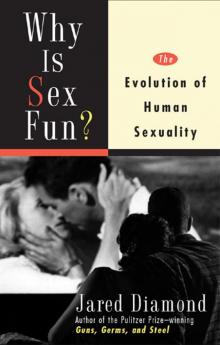 Why Is Sex Fun?: The Evolution of Human Sexuality
Why Is Sex Fun?: The Evolution of Human Sexuality Guns, Germs, and Steel: The Fates of Human Societies
Guns, Germs, and Steel: The Fates of Human Societies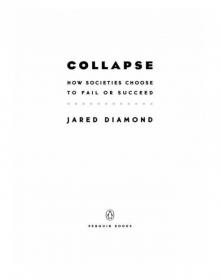 Collapse: How Societies Choose to Fail or Succeed
Collapse: How Societies Choose to Fail or Succeed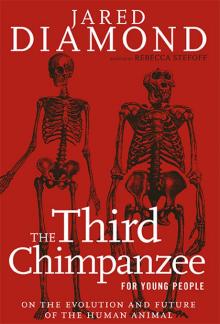 The Third Chimpanzee: The Evolution and Future of the Human Animal
The Third Chimpanzee: The Evolution and Future of the Human Animal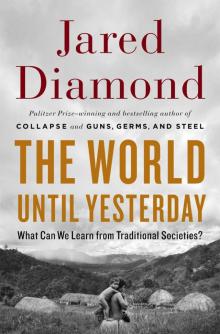 The World Until Yesterday: What Can We Learn From Traditional Societies?
The World Until Yesterday: What Can We Learn From Traditional Societies?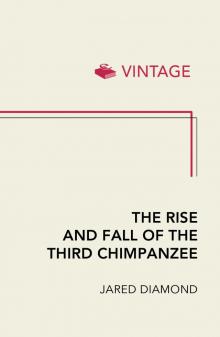 The Rise and Fall of the Third Chimpanzee
The Rise and Fall of the Third Chimpanzee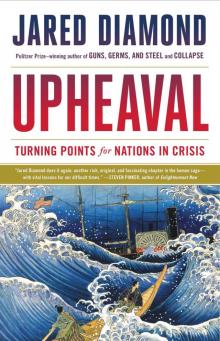 Upheaval: Turning Points for Nations in Crisis
Upheaval: Turning Points for Nations in Crisis Guns, Germs, and Steel
Guns, Germs, and Steel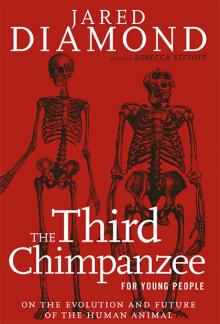 The Third Chimpanzee for Young People
The Third Chimpanzee for Young People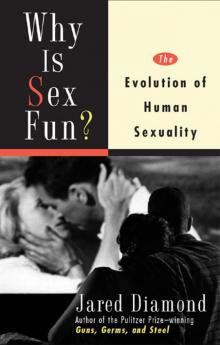 Why Is Sex Fun?
Why Is Sex Fun?